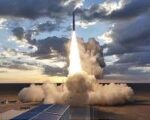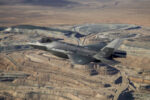On October 18, 2025, the Swedish Defence Materiel Administration (FMV) formally took delivery of the first serial-production JAS 39E Gripen multirole fighter from Saab. This marks a critical milestone in Sweden’s long-term airpower modernization strategy and signals the operational ramp-up of one of Europe’s most advanced fourth-generation-plus combat aircraft.
Gripen E Enters Swedish Service After Years of Development
The delivery ceremony took place at Saab’s Linköping facility in southern Sweden and included representatives from FMV and the Swedish Air Force (Flygvapnet). The aircraft is part of a broader contract signed in 2013 under which Sweden committed to acquiring 60 Gripen Es to replace its aging fleet of JAS 39C/D variants. The FMV confirmed that this first aircraft will now be used for continued operational testing and pilot conversion training at F7 Wing in Såtenäs.
The Gripen E program has experienced several delays since its inception due to software integration challenges and evolving operational requirements. However, with Brazil also receiving its first locally assembled F-39E (the Brazilian designation for the Gripen E) earlier this year via Embraer’s Gavião Peixoto facility, the program is now entering a steady production phase with deliveries expected to accelerate through 2026–2028.
Key Technological Upgrades Over Previous Variants
The Gripen E represents a substantial leap over the earlier C/D models. While externally similar in appearance to its predecessors, nearly all internal systems have been redesigned or upgraded:
- AESA Radar: Equipped with the Leonardo ES-05 Raven active electronically scanned array radar offering wide field-of-regard via a swashplate mount—providing superior tracking angles compared to fixed-array systems.
- IRST System: The Skyward-G infrared search-and-track sensor allows passive detection of stealthy or non-emitting targets at long range.
- EW Suite: Saab’s integrated electronic warfare system includes digital RF memory (DRFM)-based jamming capabilities and missile approach warning sensors.
- Increased Payload & Range: A more powerful General Electric F414G engine and expanded internal fuel capacity enable longer combat radius and higher payload limits.
- Modular Avionics Architecture: Open mission systems allow rapid software updates and third-party weapon integration without OEM lock-in.
This architecture positions the Gripen E as a cost-effective yet technologically competitive platform among peer fourth-gen+ fighters like the Rafale F4 or Eurofighter Typhoon Tranche 4.
Tactical Implications for Swedish Defense Posture
The introduction of the Gripen E significantly enhances Sweden’s deterrence posture amid heightened regional tensions following Russia’s full-scale invasion of Ukraine. With Finland now a NATO member and Sweden expected to finalize accession imminently, interoperability with NATO air assets has become an increasingly important requirement.
The new variant supports Link-16 datalink communications as well as future compliance with NATO IFF Mode 5 standards. Its sensor fusion capabilities are designed for networked operations alongside AEW&C platforms like Sweden’s S100D Argus or NATO AWACS assets. Furthermore, Saab is working on integrating stand-off weapons like MBDA’s Meteor BVRAAM and Taurus KEPD-350 cruise missiles—extending Sweden’s strike reach well beyond national borders if required.
Pilot Training and Operational Conversion Timeline
The first delivered aircraft will remain at Såtenäs Air Base under F7 Wing for operational test & evaluation (OT&E) purposes. According to FMV officials cited by Janes Defence Weekly (Oct. 2025), initial operational capability (IOC) is targeted for late 2026 after sufficient numbers are delivered and pilot conversion ramps up.
Pilots transitioning from JAS 39C/D require significant retraining due to new cockpit layouts featuring wide-area displays (WADs), helmet-mounted cueing systems (HMCS), and new human-machine interface paradigms prioritizing sensor fusion over traditional radar-centric workflows. Saab has provided full-mission simulators as part of its support package under FMV contract terms signed in previous years.
Bilateral Synergies with Brazil Enhance Industrial Base
The Gripen E program is unique among Western fighter programs due to its binational structure involving Brazil as both customer and co-producer. Under an agreement signed between Saab and Embraer Defense & Security in October 2014, Brazil contributes final assembly work on several units while also participating in avionics development through AEL Sistemas—a subsidiary focused on mission computers and WADs tailored for Latin American users.
This industrial cooperation not only reduces per-unit costs via economies of scale but also ensures long-term sustainability through shared logistics chains across continents. Analysts note that such arrangements could serve as models for future European defense-industrial partnerships beyond traditional EU/NATO frameworks—especially relevant given current debates around strategic autonomy within Europe’s defense sector post-Brexit.
Export Prospects Remain Mixed Amid Fierce Competition
Despite strong technical credentials and relatively low operating costs (~$4k–6k per flight hour), export success for the Gripen E has been limited so far compared to U.S.-made platforms like the F-16 Block 70/72 or F-35A Lightning II. Recent bids have seen mixed outcomes:
- Croatia opted for used Rafales over new-build Gripens in late 2021 citing faster delivery timelines;
- Finland selected F-35A over Gripen E/F + GlobalEye combo citing broader ISR capabilities;
- Czech Republic remains undecided between extending JAS-39C leases or transitioning to newer types;
- Austrian interest exists but no formal RfP issued as of Q4–2025;
Nonetheless, Saab continues marketing efforts across Latin America (Colombia), Africa (Botswana), Eastern Europe (Slovakia), and Southeast Asia—where affordability combined with sovereign upgrade paths remains attractive versus U.S.-centric alternatives tied tightly into Foreign Military Sales processes.
A Platform Built for Sovereign Control
A key differentiator for many potential customers is that unlike U.S.-built fighters which often come with strict end-use monitoring clauses under ITAR regulations, the Gripen offers full sovereign control over mission data files (MDFs), electronic warfare libraries, source codes where applicable—and even local assembly options depending on order size.
This appeals particularly to nations seeking strategic autonomy without compromising on capability—a factor that may grow more prominent amid rising geopolitical fragmentation globally. With Sweden now fielding its own units domestically starting this year, confidence in platform maturity should rise accordingly among prospective buyers still evaluating options beyond Lockheed Martin’s dominant offerings.
Outlook: Full Operational Capability by Late Decade
If current timelines hold steady—with roughly a dozen aircraft delivered annually—the Flygvapnet could achieve full operational capability (FOC) with all planned units by ~2030. In parallel, ongoing upgrades such as AI-assisted threat recognition algorithms within EW suites or future integration of directed energy weapons remain under study within Saab R&D pipelines funded jointly by FMV innovation grants since FY2023–24 budget cycles began allocating increased defense spending post-NATO accession planning began in earnest.
The arrival of this first production unit thus marks not just a symbolic handover—but a tangible step toward reshaping Nordic airpower dynamics amid an increasingly contested Baltic security environment where fast reaction times and multi-domain awareness are paramount survival traits rather than luxuries.










